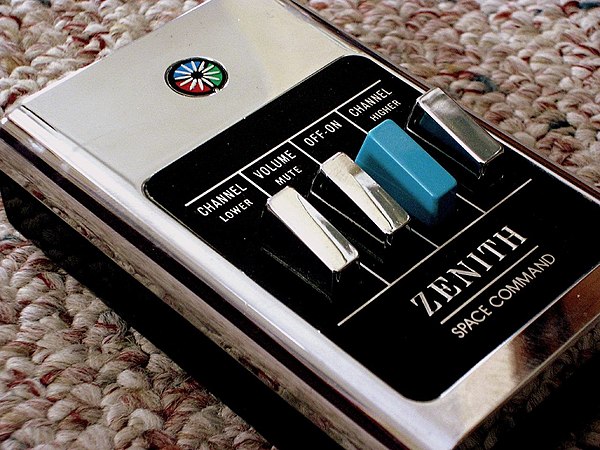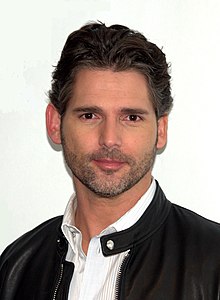Portal:Television
The Television Portal

Television (TV) is a telecommunication medium for transmitting moving images and sound. The term can refer to a television set, or the medium of television transmission. Television is a mass medium for advertising, entertainment, news, and sports.
Television became available in crude experimental forms in the 1920s, but only after several years of further development was the new technology marketed to consumers. After World War II, an improved form of black-and-white television broadcasting became popular in the United Kingdom and the United States, and television sets became commonplace in homes, businesses, and institutions. During the 1950s, television was the primary medium for influencing public opinion. In the mid-1960s, color broadcasting was introduced in the U.S. and most other developed countries.
In 2013, 79% of the world's households owned a television set. The replacement of earlier cathode-ray tube (CRT) screen displays with compact, energy-efficient, flat-panel alternative technologies such as LCDs (both fluorescent-backlit and LED), OLED displays, and plasma displays was a hardware revolution that began with computer monitors in the late 1990s. Most television sets sold in the 2000s were flat-panel, mainly LEDs. Major manufacturers announced the discontinuation of CRT, Digital Light Processing (DLP), plasma, and even fluorescent-backlit LCDs by the mid-2010s. LEDs are being gradually replaced by OLEDs. Also, major manufacturers have started increasingly producing smart TVs in the mid-2010s. Smart TVs with integrated Internet and Web 2.0 functions became the dominant form of television by the late 2010s. (Full article...)
Selected article -
Selected image -

A remote control is an electronic device used for the remote operation of a machine. The term remote control can be also referred to as "remote" or "controller" when abbreviated. It is known by many other names as well, such as the "clicker", "channel-changer", "splat", "magic hand", etc. Commonly, remote controls are used to issue commands from a distance to televisions or other consumer electronics such as stereo systems and DVD players.
Did you know (auto-generated) -

- ... that a television in the film Day of Reckoning includes scenes from Big Ass Spider!?
- ... that a television station spent so little on programming that a media columnist called it the "IOUs of Cincinnati"?
- ... that South Carolina's first television station, WCOS-TV, "could not stand the economic gaff" and folded less than three years after starting up?
- ... that a federal marshal seized a car and a truck because there was no other way to satisfy a debt owed by Arkansas television station KRZB-TV?
- ... that Ernst Jacobi, known for portraying Gauleiter Löbsack in Volker Schlöndorff's film The Tin Drum, played more than 200 roles as a television actor?
- ... that Digital pulled their HiNote Ultra laptop out of a manila envelope on television nearly 15 years before Apple did the same?
Selected quote -
More did you know
- ...that noitulovE, a cinema and television advertising campaign for Guinness draught stout, won more awards than any other commercial worldwide in 2006?
- ...that the air-date of "The Beginning of the End", the fourth season premiere of the television series Lost, means that the season may be interrupted by the 2007 Writers Guild of America strike even if a settlement is reached?
- ...that the participants of the Channel 4 programme Dumped were not told that they would be living on a landfill site for three weeks?
- ...that Gordon Murray, the creator of classic British children's television shows Trumpton, Camberwick Green and Chigley, burnt all but one of his puppets on a bonfire in the 1980s?
- ... that The Owl Service, a 1969 TV adaptation of the novel, was the first fully-scripted colour production by Granada Television?
Selected biography -
Eric Banadinović, AM (born 9 August 1968), known professionally as Eric Bana (/ˈbænə/), is an Australian actor. He began his career in the sketch comedy series Full Frontal before gaining notice in the comedy drama The Castle (1997). He achieved further critical recognition for starring in the biographical crime film Chopper (2000), and as the titular character in Hulk (2003).
After a decade of roles in Australian TV shows and films, Bana gained Hollywood's attention for his performance in the war film Black Hawk Down (2001). He played Hector in the war epic Troy (2004), and took a leading role in Steven Spielberg's historical thriller Munich (2005). In 2009, he played the villain Nero in the science-fiction film Star Trek, which was a critical and commercial success. Bana continued to work steadily in the 2010s, portraying Lieutenant commander Erik S. Kristensen in Lone Survivor (2013), and playing police sergeant Ralph Sarchie in the horror film Deliver Us from Evil (2014). In 2018, Bana played the title role in a true crime miniseries, Dirty John. In 2020, he returned to Australia to star in outback thriller The Dry. (Full article...)General images
The inaugural award, made at the 1993 ESPY Awards, was presented to the American college basketball player, coach, and broadcaster Jim Valvano. In 1993, ESPN partnered with Valvano to create the V Foundation which presents the annual Jimmy V Award to "a deserving member of the sporting world who has overcome great obstacles through perseverance and determination." Suffering from cancer, Valvano gave the inaugural Arthur Ashe Courage Award acceptance speech which "brought a howling, teary-eyed Madison Square Garden to its feet". Valvano died two months after receiving the award. Although the award is usually given to individuals, it has been presented to multiple recipients on seven occasions: former athletes on United Airlines Flight 93 (2002), Pat and Kevin Tillman (2003), Emmanuel Ofosu Yeboah and Jim MacLaren (2005), Roia Ahmad and Shamila Kohestani (2006), Trevor Ringland and David Cullen (2007), and Tommie Smith, John Carlos (2008), and survivors of the USA Gymnastics sex abuse scandal (2018). The accolade has been presented posthumously on five occasions. (Full article...)
Transliteration: "Shinigami ni Natchatta Hi" (Japanese: 死神になっちゃった日)Noriyuki AbeNoriyuki AbeMasashi SogoOctober 5, 2004September 9, 2006
2"A Shinigami's Work"
Transliteration: "Shinigami no Oshigoto" (Japanese: 死神のお仕事)Jun'ya KoshibaJun'ya KoshibaNatsuko TakahashiOctober 12, 2004September 16, 2006
3"The Older Brother's Wish, the Younger Sister's Wish"
Transliteration: "Ani no Negai, Imōto no Negai" (Japanese: 兄の願い、妹の願い)Noriyuki AbeShigeki HatakeyamaNatsuko TakahashiOctober 19, 2004September 23, 2006
4"Cursed Parakeet"
Transliteration: "Noroi no Inko" (Japanese: 呪いのインコ)Hidehito UedaTakuji KimuraGenki YoshimuraOctober 26, 2004September 30, 2006
5"Beat the Invisible Enemy!"
Transliteration: "Mienai Teki o Nagure!" (Japanese: 見えない敵を殴れ!)Tetsuhito SaitōKazunori MizunoGenki YoshimuraNovember 2, 2004October 7, 2006
6"Fight to the Death! Ichigo vs. Ichigo"
Transliteration: "Shitō! Ichigo VS Ichigo" (Japanese: 死闘!一護VSイチゴ)Motosuke TakahashiJun'ya KoshibaMichiko YokoteNovember 9, 2004October 14, 2006
7"Greetings from a Stuffed Lion"
Transliteration: "Nuigurumi kara Konnichiwa" (Japanese: ぬいぐるみからコンにちは)Motosuke Takahashi
Shigeki HatakeyamaAkira ShimizuMichiko Yokote
Masashi SogoNovember 16, 2004October 21, 2006
8"June 17, Memories in the Rain"
Transliteration: "Roku-gatsu Jūshichi-nichi, Ame no Kioku" (Japanese: 6月17日、雨の記憶)Noriyuki AbeShigeki HatakeyamaMasashi SogoNovember 23, 2004October 28, 2006
9"Unbeatable Enemy"
Transliteration: "Taosenai Teki" (Japanese: 倒せない敵)Sanzō TsunodaTakuji KimuraMasashi SogoNovember 30, 2004November 4, 2006
10"Assault on Trip at Sacred Ground!"
Transliteration: "Burari Reijō Totsugeki no Tabi!" (Japanese: ぶらり霊場突撃の旅!)Kazunori MizunoKazunori MizunoMasahiro ŌkuboDecember 7, 2004November 11, 2006
11"The Legendary Quincy"
Transliteration: "Densetsu no Kuinshī" (Japanese: 伝説のクインシー)Jun'ya KoshibaJun'ya KoshibaMichiko YokoteDecember 14, 2004November 18, 2006
12"A Gentle Right Arm"
Transliteration: "Yasashii Migiude" (Japanese: やさしい右腕)Kōji AritomiKōji AritomiGenki YoshimuraDecember 21, 2004November 25, 2006
13"Flower and Hollow"
Transliteration: "Hana to Horō" (Japanese: 花とホロウ)Sanzō TsunodaTakuji KimuraNatsuko TakahashiDecember 28, 2004December 2, 2006
14"Back to Back, a Fight to the Death!"
Transliteration: "Senaka Awase no Shitō!" (Japanese: 背中合わせの死闘!)Tetsuhito SaitōNoriyuki AbeMasashi SogoJanuary 11, 2005December 9, 2006
15"Kon's Great Plan"
Transliteration: "Kon no Uhauha Daisakusen" (Japanese: コンのウハウハ大作戦)Chiaki KonChiaki KonMasahiro ŌkuboJanuary 18, 2005December 16, 2006
16"The Encounter, Abarai Renji!"
Transliteration: "Abarai Renji, Kenzan!" (Japanese: 阿散井恋次、見参!)Motosuke TakahashiJun'ya KoshibaMichiko YokoteJanuary 25, 2005January 6, 2007
17"Ichigo Dies!"
Transliteration: "Ichigo, Shisu!" (Japanese: 一護、死す!)Manabu FukazawaKazunori MizunoRika NakaseFebruary 1, 2005January 13, 2007
18"Reclaim! The Power of the Shinigami!"
Transliteration: "Torimodose! Shinigami no Chikara!" (Japanese: 取り戻せ!死神の力!)Jun'ya KoshibaAkira ShimizuNatsuko TakahashiFebruary 8, 2005January 20, 2007
19"Ichigo Becomes a Hollow!"
Transliteration: "Ichigo, Horō ni Ochiru!" (Japanese: 一護、ホロウに墜ちる!)Tetsuhito SaitōTakuji KimuraGenki YoshimuraFebruary 15, 2005January 27, 2007
20"Ichimaru Gin's Shadow"
Transliteration: "Ichimaru Gin no Kage" (Japanese: 市丸ギンの影)Shigeki HatakeyamaShigeki HatakeyamaMasashi SogoFebruary 22, 2005February 3, 2007 (Full article...)
Twelve episodes were produced. They originally aired on Tokyo Broadcasting System's satellite station BS-i, from July 18, 2003 through October 3, 2003, and were also made available at the same time on the Bandai Channel. On August 27 and 28, 2003, an event with the first volume Japanese DVD of Popotan was shown Animate Ikebukuro in Japan. The event featured guest appearances by the anime's voice actress for the three sisters. (Full article...)
News
- December 28: US professional wrestler Jon Huber dies aged 41
- September 2: Tributes paid to recently deceased US actor Chadwick Boseman
- May 24: Japanese professional wrestler and Netflix star Hana Kimura dies aged 22
- January 16: BBC newsreader Alagiah to undergo treatment for bowel cancer
- Upcoming events
Featured content
Main topics
History of television: Early television stations • Geographical usage of television • Golden Age of Television • List of experimental television stations • List of years in television • Mechanical television • Social aspects of television • Television systems before 1940 • Timeline of the introduction of television in countries • Timeline of the introduction of color television in countries
Inventors and pioneers: John Logie Baird • Alan Blumlein • Walter Bruch • Alan Archibald Campbell-Swinton • Allen B. DuMont • Philo Taylor Farnsworth • Charles Francis Jenkins • Boris Grabovsky • Paul Gottlieb Nipkow • Constantin Perskyi • Boris Rosing • David Sarnoff • Kálmán Tihanyi • Vladimir Zworykin
Technology: Comparison of display technology • Digital television • Liquid crystal display television • Large-screen television technology • Technology of television
Terms: Broadcast television systems • Composite monitor • HDTV • Liquid crystal display television • PAL • Picture-in-picture • Pay-per-view • Plasma display • NICAM • NTSC • SECAM
Categories
WikiProjects

|
You are invited to participate in WikiProject Television, a WikiProject dedicated to developing and improving articles about Television. |
- Main projects
- Sub-projects
Television Stations • American animation • American television • Australian television • British TV • BBC • Canadian TV shows • Television Game Shows • ITC Entertainment Productions • Digimon • Buffyverse • Doctor Who • Degrassi • EastEnders • Episode coverage • Firefly • Futurama • Grey's Anatomy • Indian television • Lost • Nickelodeon • The O.C. • Professional Wrestling • Reality TV • The Simpsons • Seinfeld • South Park • Stargate • Star Trek • Star Wars • Soap operas • Avatar: The Last Airbender • House
- Related projects
Animation • Anime and manga • Comedy • Comics • Fictional characters • Film • Media franchises
What are WikiProjects?
Things you can do

- Place the {{WikiProject Television}} project banner on the talk pages of all articles within the scope of the project.
- Write: Possible Possum
- Cleanup: color television, Alien Nation: Body and Soul, The Sopranos, Alien Nation: Dark Horizon, Alien Nation: The Enemy Within, Alien Nation: Millennium, Aang
- Expand: Timeline of the introduction of color television in countries
- Stubs: Flow (television), Just for Kicks (TV series), Play of the Month, Nova (Dutch TV series), More stubs...
Subportals
Related portals
Associated Wikimedia
The following Wikimedia Foundation sister projects provide more on this subject:
-
Commons
Free media repository -
Wikibooks
Free textbooks and manuals -
Wikidata
Free knowledge base -
Wikinews
Free-content news -
Wikiquote
Collection of quotations -
Wikisource
Free-content library -
Wikiversity
Free learning tools -
Wiktionary
Dictionary and thesaurus




























































